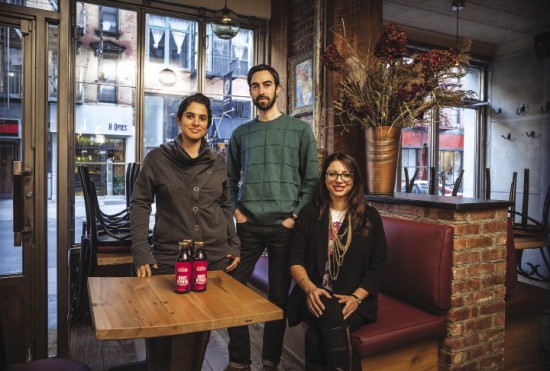It’s a gray, blustery day when I meet Jackie Lilinshtein and Jeff Yoskowitz under the elevated tracks on Brighton Beach Avenue. Friends since childhood, the two are founders of the Gefilteria, a new Clinton Hill–based boutique purveyor of old-world Jewish foods, and have promised me a gastronomic tour of Brighton Beach.
The tight-knit Eastern European community can be difficult to navigate without the aid of a local; fortunately, Lilinshtein’s mother owns a pharmacy here, so she’s intimately familiar with the rhythms of the neighborhood and the rumble of the train above. Some Brooklyn chowhounds ride the Q out here for the vodkas served in ice blocks or the frosty steins of Baltika, but I’m here in search of a different mother-country brew: kvass.
A naturally fermented, slightly fizzy drink made from rye bread, beets or, occasionally, lettuce, kvass has been refreshing Eastern Europeans for centuries. The first known recording of kvass appears over a millennium ago, circa 989; Russian writers Fyodor Dostoevsky, Leo Tolstoy and Anton Chekhov all referenced the drink in their work. Lighter than beer and tastier than water, kvass—with an ABV of less than 1 percent—is ideal for everyday drinking.
It’s tough to pinpoint the exact arrival of the beverage on Brooklyn’s shores, but there’s a long history of Eastern European influence in Brighton Beach, affectionately nicknamed “Little Odessa.” An influx of Jewish refugees made the neighborhood their home after World War II, and a flood of Soviet immigrants poured into the area in the ’70s, when Soviet authorities loosened emigration restrictions. Lilinshtein’s father came here from Ukraine in 1975, her mother from St. Petersburg in 1978.
Lilinshtein recalls watching women in babushkas sell kvass from barrels on the boardwalk when she was growing up. But while kvass may have arrived in America as a peasant drink, today the American influence shows: Production is as much about convenience as tradition. Much of the kvass sold in the crowded groceries along Brighton Beach Avenue is light on rye and heavy on high-fructose corn syrup, and even in restaurants quality versions are becoming harder to find.
Inna Shpiro, an Odessa native who’s run Brighton boardwalk stalwart Café Volna for 31 years, says she made her own kvass the traditional way once—by fermenting stale rye bread in water—but didn’t like the taste. Instead, she mixes a malted rye powder into water and seals it into a barrel, pumping in air to enhance the drink’s trademark fizz. The result is light and sweet—or, as Shpiro describes it, “soft,” with a pleasant tang and subtle bubbles that help cut the hearty Russian homestyle fare that emerges from Volna’s kitchens. In summer, she pours kvass over chopped vegetables and sausage to make a cold soup called “oroshka,” a cousin to borscht.
While Volna may have embraced modern advancements in kvass-making technology, Lilinshtein and Yoskowitz decided to do things the old-fashioned way, even if they’ve never set foot in the old country. They see the Gefilteria, which they founded along with partner Liz Alpern, as a return to their roots. The youthful crew (Lilinshtein is 27, Yoskowitz and Alpern 28) makes traditional Ashkenazi food, like gefilte fish and pickles, with carefully sourced, market-fresh ingredients in an effort to introduce a new generation to seriously old-school eats—including artisanal kvass.
Yoskowitz, a Clinton Hill resident who has worked on farms in New York and Israel, is the pickling and fermenting geek of the bunch. Kvass was the second food he started experimenting with after gefilte fish, but deciding upon a style was an initial conundrum: Russians generally use the term to refer to the rye drink, while Polish audiences think of beet juice, and still others associate the term more with a borscht base than a beverage. Then there are a handful of natural-food companies making highly potent, tonic-like versions from beets and cabbage, touting the drink’s health benefits (beets reportedly tonify the liver and act as a cleanser).
Careful thought went into the appropriate branding. “We called it beet tonic at first, then borscht drink,” says Yoskowitz. “Sometimes we refer to it as ‘Jewish kombucha.’” Eventually, they settled on the straightforward: “beet kvass.”
The Gefilteria’s ginger-laced drink has made a splash at their stands at the Brooklyn Flea and the Hester Street Market, and some Brooklyn bartenders have begun sniffing around kvass as a cocktail ingredient, spurred by a delicious concoction the Gefilteria group makes for events and pop-up parties: a refreshing cocktail with gin, agave, mint, seltzer and a dash of kvass, which lends a beautiful ruby hue to the tipple.
Back in Brighton Beach, Lilinshtein says her Russian goodbyes to the shop owners she’s known since childhood, and we settle into the long Q ride back from Brighton Beach. As the train pulls away from the shimmering water below, she waxes about how her what’s-old-is-new gefilte gig fits into the borough’s burgeoning food scene.
“There’s a lot of respect for the food and each other,” she says of the zeitgeist. “It’s a model based on integrity, not just profit.” The Q rumbles to their stop, and with that we part ways, Yoskowitz and Lilinshtein off to tinker with kvass, the next generation of Eastern European Brooklyn entrepreneurs.
Photo credit: Noah Fecks



